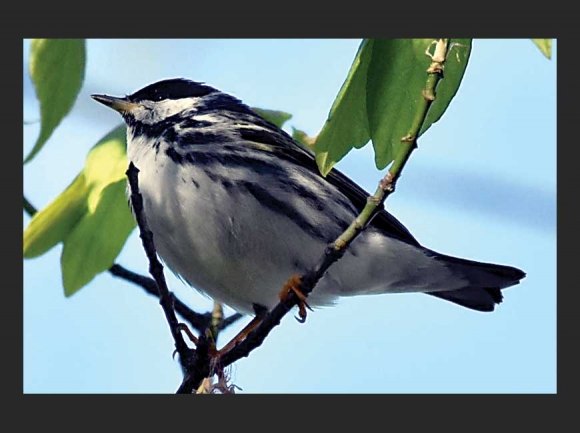The Naturalist's Corner: Not quite a wrap
 Blackpoll warbler at Beaver Lake. Tim Carstens photo
Blackpoll warbler at Beaver Lake. Tim Carstens photo
The starting date for my annual bird survey for the U.S. Forest Service is May 1. All of our nesting species should be on territory by this date. Some, like Canada warblers, may not be here in great numbers but they will be represented in appropriate habitat.
But just because our nesting neotropical migrants are busy setting up housekeeping doesn’t mean spring migration is over. There are still some northern nesters passing through and could be a few stragglers till nearly the end of May.
One of those late neotropical migrants birders should be keeping an eye — and an ear — out for is the blackpoll warbler. The blackpoll is the most northern nesting of the wood warblers. It has an annual migration of around 12,000 miles. The blackpoll nests from Alaska across Canada and to the Great Lakes and New England and overwinters in northern South America. It can be found nesting in alder thickets north of the Arctic Circle.
A quick note about keeping an ear out for blackpolls: these birds sing almost constantly while they are foraging, which can be a blessing or a bane to birders. This warbler’s thin zeet-zeet-zeet-zeet song is one of the highest frequency songs in the avian world, coming in at around 10,000 hertz. Birders like myself, who are getting a little longer in the tooth, are always happy to hear that thin zeet-zeet-zeet. Not only because it means blackpolls are about, but because it means that high-frequency hearing is still there.
At first blush, the idea of long-distance migrants being late migrants is a little counterintuitive. I mean, if you’re planning a long trip odds are you want to get an early start because you have lots of ground to cover. But wait, if you’re going out to eat it doesn’t make any sense to get to the restaurant before it opens, right.
Most neotropical migration is timed so birds reach their nesting territories as trees and shrubs begin to leaf out and insects begin to hatch. You only need to take a ride up the Blue Ridge Parkway to around 5,000 feet now to get an idea of what Canada and Alaska look like with regards to buds and bugs.
Related Items
So with the greening of the mountains, our resident bneotropical migrants are unpacking and setting up housekeeping. Their northern cousins, however, still have their bags packed and are just passing through. Some other northern nesters still moving through our area now, along with blackpolls include Cape May warbler, magnolia warbler, bay-breasted warbler and others.
So, don’t give up on migrants just yet. One of the neat things about living in Western North Carolina is we can follow spring up the mountains. And as the lower elevations leaf out and blackburnians, northern parulas and other tiny treetop dwellers disappear in the foliage, just head up another thousand feet and you can once again catch them foraging on buds about to burst.
(Don Hendershot is a naturalist and a writer who lives in Haywood County. He can be reached at This email address is being protected from spambots. You need JavaScript enabled to view it.)









